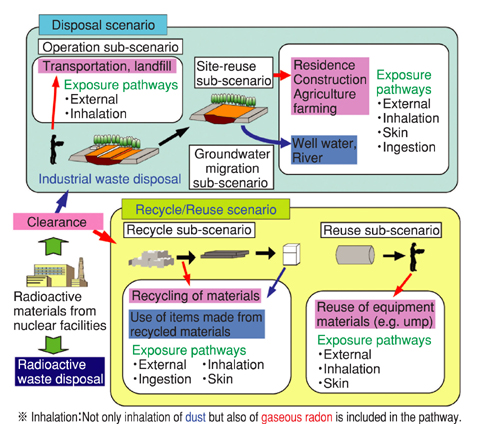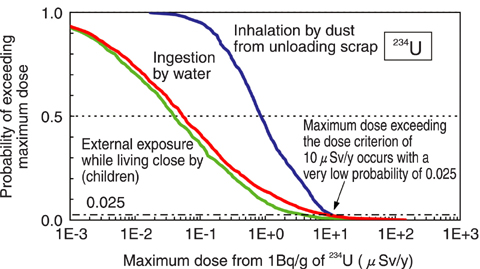
Fig.5-19 Scenarios and exposure pathways used to derive the clearance levels for uranium waste and TRU waste

Radioactive materials generated from operation and dismantling of nuclear facilities include those with extremely low levels of radioactivity. The clearance level concept is used to categorize such materials as not requiring treatment as radioactive wastes. The radionuclide concentration below which such treatment is not required is called the clearance level. The "cleared" material is either reused/recycled or disposed of as industrial waste. The Nuclear Reactor Regulation Law was amended to set the clearance levels for short-lived radionuclides contained in the waste from major nuclear facilities. It is also necessary to set the method for deriving the clearance levels of uranium and transuranium (TRU) wastes. These wastes contain long-lived radionuclides in decay chains.
We developed a probabilistic assessment code system (PASCLR ver.2) to derive the clearance levels of radionuclides contained in the uranium and TRU wastes. This code supports the dose estimation for the exposure pathways in two typical scenarios; landfill disposal of industrial waste and recycling or reuse of the released materials (Fig.5-19). The growth of daughter radionuclides in decay chains can lead to a high dose contribution over a long time periods. This code can estimate such long time effects for all exposure pathways considered. The contribution from gaseous radon (222Rn) is included in the calculations.
Uncertainties in the parameters used in the clearance level calculations include observational error and variations in the environmental conditions at the disposal site. The effect of these uncertainties on the clearance levels obtained from the deterministic analysis can be accounted for in a probabilistic calculation using the Monte Carlo technique (Fig.5-20).
These results, as well as consideration of the consistency of international clearance levels reported by the IAEA, will contribute to the future establishment of the clearance levels for uranium and TRU wastes by this regulatory body.
This work was performed by JAEA under contract with Nuclear and Industrial Safety Agency in Ministry of Economy, Trade and Industry.